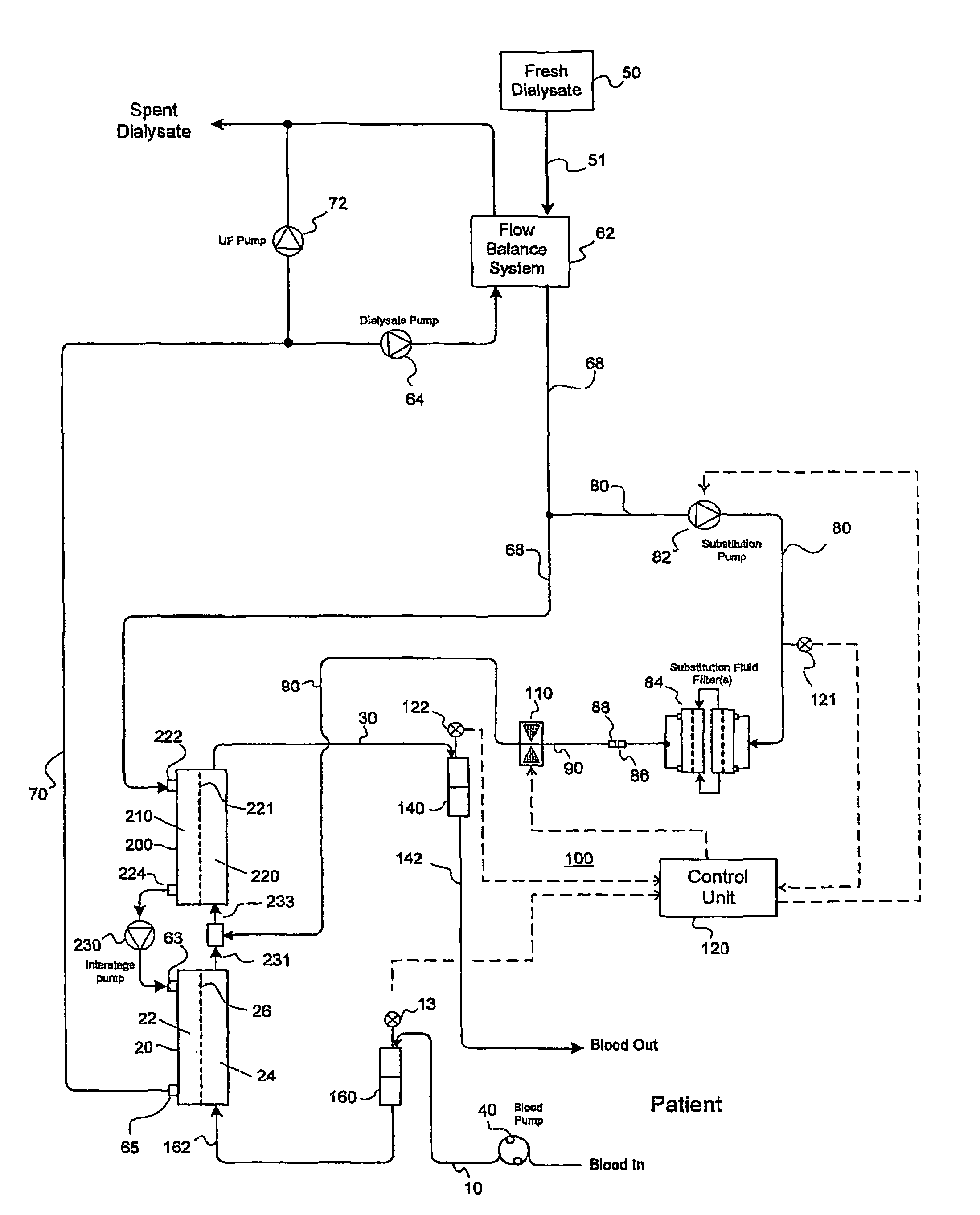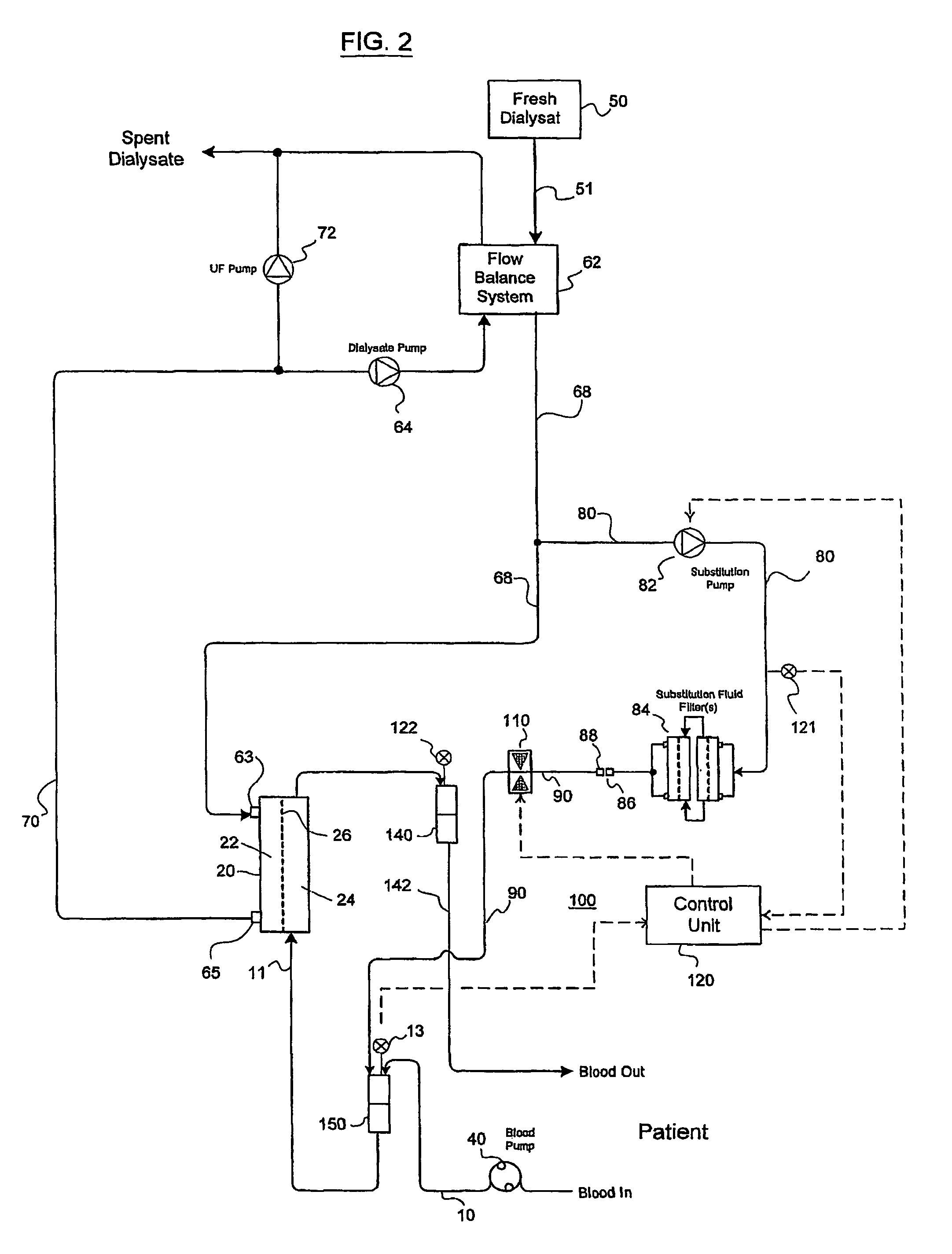Valve mechanism for infusion fluid systems
a valve mechanism and fluid system technology, applied in the direction of filtration separation, multi-stage water/sewage treatment, separation process, etc., can solve the problems of contaminated final sterility filter, no prevention mechanism, and no cost comparison,
- Summary
- Abstract
- Description
- Claims
- Application Information
AI Technical Summary
Benefits of technology
Problems solved by technology
Method used
Image
Examples
first embodiment
[0038]In this embodiment, the first monitoring device 13 acts as a downstream sensor for monitoring the fluid pressure at downstream locations relative to the pinch valve 110. Preferably, the arterial pressure is also measured at the location of the first monitoring device 13. As with th first embodiment, the fluid pressure of the substitution fluid is continuously monitored at the upstream sensor 121.
[0039]In this embodiment, the second monitoring device 122 (i.e. the second sensor) does not serve as a downstream sensor for monitoring the flow pressure of the substitution fluid after the fluid passes through the pinch valve 110 but rather acts as a venous pressure sensor. Sensor 122 thus measures the pressure of the fluid as it enters the chamber 140. Chamber 140 is therefore not a mixing chamber but rather is a chamber which receives the fluid from the dialyzer cartridge 20 and is coupled to conduit 142 which delivers the filtered blood back to the patient. Alternatively, chamber ...
second embodiment
[0041]Advantageously, the second embodiment prevents retrograde blood flow from the chamber 150 into the flexible tubing 90 which is connected thereto in a pre-dilution scheme. In each embodiment of the present invention, the valve mechanism 100 is easily incorporated into a variety of existing hemodiafiltration apparatus or the like.
[0042]Reference is made to FIG. 3 which schematically illustrates a third embodiment of the present invention. In this third embodiment, the present invention is shown as being part of a substitution fluid delivery system typical of a hemodiafiltration system having first and second dialyzer cartridges 20, 200 in which the sterile substitution fluid is introduced at a location between the first and second dialyzer cartridges 20, 200. The substitution fluid can be introduced (i.e., through a connector) into a conduit that extends between and links the first and second dialyzer cartridges 20, 200 or the substitution fluid can be introduced into a chamber ...
third embodiment
[0043]In this third embodiment, blood is propelled through the extracorporeal circuit using the blood pump 40. The blood flows through the bloodline 10 to the chamber 160. The arterial pressure is measured at the first monitoring device 13 and the measured information is continuously transmitted to the control unit 120. A conduit (bloodline) 162 fluidly connects the chamber 160 to the first dialyzer cartridge 20. The second dialyzer cartridge 200 is similar to the first dialyzer cartridge 20 and may be of any type suitable for hemodialysis, hemodiafiltration, hemofiltration, or heomoconcentration as is the case with the first dialyzer cartridge 20. More specifically, the second dialyzer cartridge 200 has a dialysate compartment 210 and a blood compartment 220 defined by a semipermeable membrane 221. The second dialysate cartridge 200 also includes a dialysate inlet port 222 for receiving a flow of dialysate fluid and a dialysate outlet port 224 which carries spent dialysate fluid fr...
PUM
| Property | Measurement | Unit |
|---|---|---|
| pore size | aaaaa | aaaaa |
| molecular weight | aaaaa | aaaaa |
| flow pressure | aaaaa | aaaaa |
Abstract
Description
Claims
Application Information
 Login to View More
Login to View More - R&D
- Intellectual Property
- Life Sciences
- Materials
- Tech Scout
- Unparalleled Data Quality
- Higher Quality Content
- 60% Fewer Hallucinations
Browse by: Latest US Patents, China's latest patents, Technical Efficacy Thesaurus, Application Domain, Technology Topic, Popular Technical Reports.
© 2025 PatSnap. All rights reserved.Legal|Privacy policy|Modern Slavery Act Transparency Statement|Sitemap|About US| Contact US: help@patsnap.com



